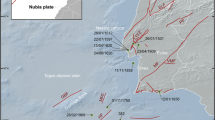Abstract
As the Wenchuan Earthquake was of high magnitude and shallow seismic focus, it caused great damage and serious geohazards. By the field investigation and the interpretation of remote-sensing information after the earthquake and by using means of GIS technology, the distribution of geohazards triggered by the earthquake are analyzed and the conclusions are as follows: (1) The earthquake geohazards showed the feature of zonal distribution along the earthquake fault zone and linear distribution along the rivers; (2) the distribution of earthquake geohazards had a marked hanging wall effect, for the development density of geohazards in the hanging wall of earthquake fault zone was obviously higher than that in the foot wall and the width of strong development zone in the hanging wall was about 10 km; (3) the topographical slope was a main factor which controlled the development of earthquake geohazards and a vast majority of hazards were distributed on the slopes of 20° to 50°; (4) the earthquake geohazards had a corresponding relationship with the elevation and micro-landform, for most hazards happened in the river valleys and canyon sections below the elevation of 1500 to 2000 m, particularly in the upper segment of canyon sections (namely, the turning point from the dale to the canyon). Thin ridge, isolated or full-face space mountains were most sensitive to the seismic wave, and had a striking amplifying effect. In these areas, collapses and landslides were most likely to develop; (5) the study also showed that different lithologies determined the types of geohazards, and usually, landslides occurred in soft rocks, while collapses occurred in hard rocks.
Similar content being viewed by others
References
Parsons T, Ji C, Kirby E. Stress changes from the 2008 Wenchuan earthquake and increased hazard in the Sichuan basin. Nature, 2008, 454(7203): 509–510
Huang R Q, Xu Q. Catastrophic Landslides in China (in Chinese). Beijing: Science Press, 2008. 1–553
The Front Line Headquarter of Ministry of Land and Resource for Earthquake Rescue and Disaster Relief. Emergency hunting report of geohazards in the disaster area of “5·12”Wenchuan Earthquake, 2008
Abrahamson N A, Somerville P G. Effects of the hanging wall and footwall on ground motions recorded during the Northridge earthquake. Bull Seism Soc Amer, 1996, 86(1B): S93–S99
Abrahamson N A, Silva W J. Empirical response spectral attenuation relations for shallow crustal earthquakes. Seism Res Lett, 1997, 68(1): 94–109
Boore D M, Joyner W B, Fumal T E. Equations for estimating horizontal response spectra and peak acceleration from western North American earthquakes: a summary of recent work. Seism Res Lett, 1997, 68(1): 128–153
Campbell KW. Empirical near-source attenuation relationships for horizontal and vertical components of peak ground acceleration, peak ground velocity, and pseudo-absolute acceleration response spectra. S eism Res Lett, 1997, 68(1): 154–179
Sadigh K, Chang C Y, Egan J A, et al. Attenuation relationships for shallow crustal earthquakes based on California strong motion data. Seism Res Lett, 1997, 68(1): 180–189
Lin Q W, Lai W J, Huang M L, et al. The cause of the 1999 Chi-Chi earthquake in Taiwan and its fault active mechanism (in Chinese). Nat Sci Newslett, 1999, 11(4): 147–155
Yu Y X, Gao M T. Effects of the hanging wall and foot wall on peak acceleration during the Chi-Chi earthquake, Taiwan (in Chinese). Acta Seismologica Sinica, 2001, 23(6): 615–621
Chen Y T. Why was Wenchuan Earthquake so serious. http://www.sciencenet.cn/htmlnews/2008/6/200862781145413208421.html
Chen Y T. On the Magnitude and the Fault Length of the Great Wenchuan Earthquake (in Chinese). Sci & Tech Rev, 2008, 26(10): 26–27
Author information
Authors and Affiliations
Corresponding author
Additional information
Supported by the Key Basic Research Program of the Ministry of Science and Technology of China (Grant No. 2008CB425800)
Rights and permissions
About this article
Cite this article
Huang, R., Li, W. Development and distribution of geohazards triggered by the 5.12 Wenchuan Earthquake in China. Sci. China Ser. E-Technol. Sci. 52, 810–819 (2009). https://doi.org/10.1007/s11431-009-0117-1
Received:
Accepted:
Published:
Issue Date:
DOI: https://doi.org/10.1007/s11431-009-0117-1




